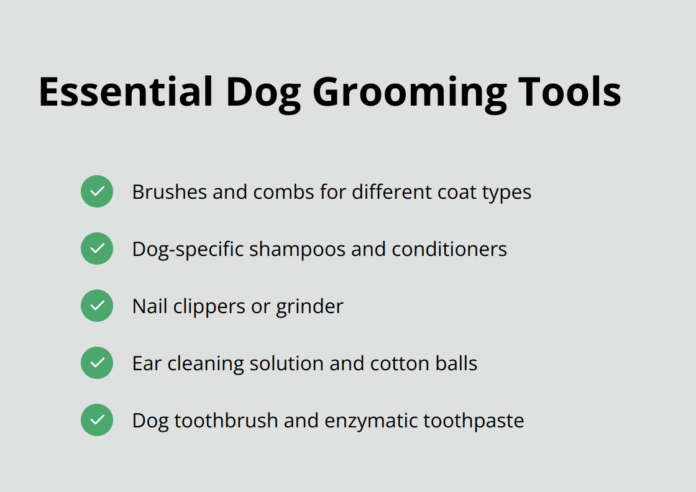“This post contains affiliate links, and I will be compensated if you make a purchase after clicking on my links.”
At DogingtonPost, we know that a well-groomed dog is a happy and healthy dog. Regular grooming not only keeps your furry friend looking their best but also helps prevent skin issues and promotes bonding.
In this guide, we’ll share expert dog groomer tips and tricks to help you master the art of at-home grooming. From essential tools to step-by-step techniques, we’ve got you covered.
What Tools Do You Need for Dog Grooming?
Proper dog grooming requires the right tools. Here’s a guide to the essential items you’ll need in your at-home grooming kit.
Brushes and Combs: Your First Line of Defense
A good brush forms the cornerstone of any grooming routine. Short-haired breeds benefit from a rubber curry brush to remove loose fur and stimulate the skin. Long-haired dogs need a slicker brush to detangle and remove mats. A metal comb helps with finishing touches and tackles stubborn knots.
Shampoos and Conditioners: Choose Wisely
Dogs need specific shampoos (not human products) due to their different skin pH. Natural Dog Company’s Sensitive Skin Oatmeal Shampoo is perfect for cleaning and healing all pups, especially those with naturally sensitive skin. Always use a conditioner after shampooing to keep the coat soft and manageable.
Nail Care: Trim with Precision
Nail trims, though often dreaded, ensure your pet’s comfort. Clip only the tip of the nail straight across, including the dewclaws located on the inner side of the paw. Avoid clipping past the curve of the nail. For nail-trim shy dogs, a quiet electric nail grinder can work wonders.
Ear Care: Keep It Clean
Ear infections plague many dogs, especially those with floppy ears. An ear cleaning solution and cotton balls are essential for regular maintenance. (Avoid using Q-tips, as they can damage the ear canal.)
Dental Care: Brush Away Problems
Invest in a finger toothbrush or a long-handled brush designed for dogs, along with enzymatic toothpaste. Regular brushing prevents dental issues and can save you thousands in vet bills.
Quality matters when it comes to grooming tools. Durable, effective products will make the grooming process smoother for both you and your dog. Now that you’ve stocked up on the right tools, let’s move on to the step-by-step guide for grooming your dog at home.
How to Groom Your Dog Like a Pro
Brush with Confidence
Start your grooming routine with brushing. Short-coated breeds benefit from a rubber curry brush used in circular motions to loosen dead hair and stimulate the skin. For long-haired dogs, use a slicker brush and work in sections from the skin outward to prevent painful tugging. Always brush in the direction of hair growth and be extra gentle around sensitive areas (like the belly and ears).
Master Bath Time
When it’s bath time, wet your dog thoroughly before applying shampoo. Focus on one section at a time, work the shampoo into a lather and rinse completely before moving to the next area. This method ensures you don’t miss spots and prevents soap residue. Pay special attention to often-neglected areas (such as between the toes and under the tail). After shampooing, apply conditioner if needed, following the same sectional approach.
Trim Nails Safely
Approach nail trimming with caution. If you hear your dog’s nails clicking on the floor, it’s time for a trim. Use sharp clippers and cut at a 45-degree angle, taking off small amounts at a time. For dogs with black nails, look for the small dark circle in the center of the nail’s cross-section – this is the quick, and you want to avoid it. If you’re unsure, trim less and more frequently.
Clean Ears and Teeth
Clean your dog’s ears weekly with a good quality ear cleaner. Gently wipe the visible part of the ear canal with a cotton ball, never insert anything into the ear. For dental care, use a dog-specific toothbrush and toothpaste. Let your dog lick a small amount of toothpaste off your finger, then gradually introduce the toothbrush. Most veterinarians recommend brushing daily for optimal oral health, focusing on the outer surfaces of the teeth where plaque tends to accumulate.
Patience is key when grooming. If your dog shows signs of stress, take breaks and offer treats to create positive associations. With practice and persistence, home grooming can become an enjoyable routine. Now that you’ve mastered the basics of at-home grooming, let’s explore when it’s best to seek professional help for your furry friend.

When to Seek Professional Dog Grooming Services
Specialized Breed Requirements
Some dog breeds need expert grooming. Poodles, for instance, require regular, intricate haircuts to maintain their distinctive appearance. The American Kennel Club recommends using a slicker brush for grooming poodles. This type of brush has a square or rectangular shape with short, stiff wire bristles. Dogs with thick undercoats (like Huskies or Malamutes) benefit from a thorough de-shedding treatment that professionals can provide more effectively than home grooming.
Handling Behavioral Challenges
If your dog becomes overly anxious or aggressive during grooming sessions, a professional can help. Certified groomers receive training to handle difficult behaviors and can often groom your pet more quickly and safely than you can at home.
Identifying Health Concerns
Professional groomers often spot potential health issues first. They can identify skin problems, lumps, or parasites that you might miss.
Choosing a Professional Groomer
When selecting a groomer, look for certifications from reputable organizations. Ask about their experience with your dog’s breed and any specific health concerns your pet may have.
Preparing for a Professional Grooming Appointment
Before the appointment, help your dog get used to being touched in sensitive areas like paws and ears. Bring your dog’s favorite treats to the grooming session to create a positive association. If your dog has any behavioral issues or health concerns, inform the groomer in advance so they can take appropriate precautions.

Final Thoughts
Regular grooming plays a vital role in your dog’s health and well-being. Our dog groomer tips and tricks help you keep your pet looking and feeling their best while strengthening your bond. Professional groomers offer expert care for specialized needs or challenging behaviors, providing tailored solutions for your dog’s specific requirements.
A consistent grooming routine ensures your dog’s comfort and happiness. Start slowly and use positive reinforcement to make grooming an enjoyable experience for both you and your pet. Patience and practice will yield great results over time.
We at DogingtonPost commit to helping you provide the best care for your canine companion. Our platform offers information on dog health, nutrition, and lifestyle to support your grooming journey and beyond. Your furry friend will thank you with wagging tails and wet kisses for years to come.

